Self Regeneration Mode
If the warning message “Self Regeneration” is stored in inspection message tap, it is operable in LCD warning message page.

-
Make sure the vehicle parked on safety zone (to avoid the flammables like grass and traffic accident).
-
Check remained fuel above 1/5 of full level fuel gauge to prevent fuel overheat.
-
Open the bonnet to prevent engine room overheat.
-
Self regeneration should be done only when DPF indicator illuminates.
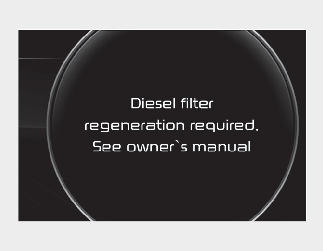
If the warning message “Diesel filter regeneration required, See owner’s manual.” appears on the LCD display, Self Regeneration is required.
To initiate Self Regeneration
-
Engage parking brake and shift lever at P state.
-
Turn on the engine.
-
Warm up the engine and check engine temperature gauge at the middle position.
-
Turn on the air conditioner and set the blower to the maximum.
-
Turn on the high beam.
-
Operate the rear defog function.
-
Hold the OK button on the LCD warning message page.
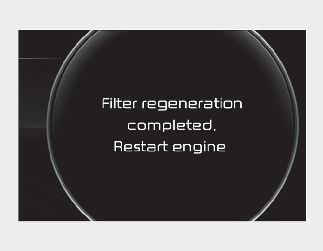
-
Turn off and turn on the engine again.
Not Operating Condition
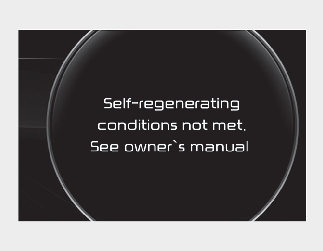
Under below condition, Diesel Catalyst regeneration process may be interrupted. (Engine RPM drops to idle state)
- Engine overheat or insufficient warm-up
- Shift lever change to D or R state- Acceleration pedal is pressed- Movement of Vehicle (Vehicle speed over 0)
Service Check
If the DPF indicator change from illuminates to blink or Engine Check Lamp (MIL) illuminates with DPF indicator in spite of the procedure, Kia recommends to visit an authorised Kia dealer/service partner and then check the Diesel Catalyst and engine system including oil level inspection. Please note that the vehicle acceleration is limited to protect engine system when DPF indicator blinks or Engine Check Lamp (MIL) illuminates.
Operating Self Regeneration Mode
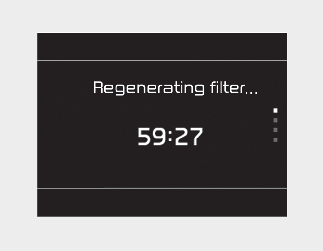
If the self regeneration mode starts, the message “Regenerating filter…” and the remaining time appears. It takes around 30~60 minutes.
Self Regeneration Mode Fail
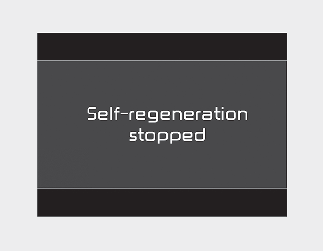
The regeneration operation could be cancelled if the driver press the OK button firmly whilst operating the self regeneration process.

If the system still needs the self regeneration process after cancelling the operation, the warning message appears. (Diesel filter regeneration required.) If the driver press the OK button firmly, it can restart the self regeneration mode again. (The Self regeneration conditions should be satisfied.)

The self regeneration process stops if any of the self regeneration conditions is cancelled. If the self regeneration process is cancelled automatically, the system maintains “Self-regeneration stopped” message.If the driver press the OK button firmly, it can restart the self regeneration mode again. (Self regeneration conditions should be satisfied.)
Selective Catalytic Reduction (if equipped)
The Selective Catalytic Reduction (SCR) system is to catalytically convert NOx to Nitrogen and Water by using the reduction agent, the urea solution.

-
It may be a criminal offence to use a vehicle that does not consume any urea solution.
-
Use of, and refilling of, a required urea solution of the correct specifications is mandatory for the vehicle to comply with the certificate of conformity issued for that vehicle type.
Urea solution level gauge (if equipped)
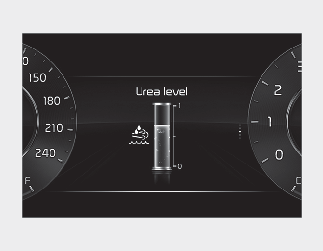
The urea solution level gauge indicates the approximate amount of remaining urea solution inside the urea solution tank.
* The urea level gauge image pops up, whenever the ENGINE START/STOP button is ON position.
Low urea solution warning message (if equipped)
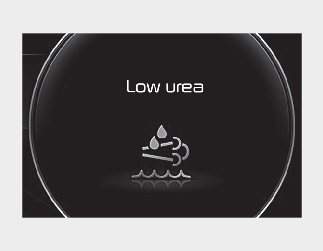
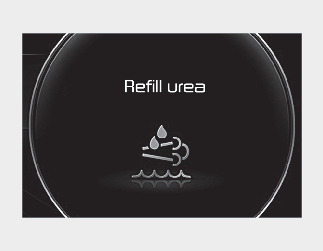
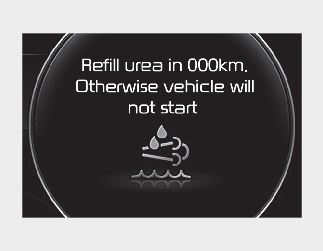
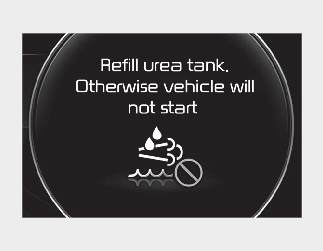
The lack warning messages of urea solution appear below urea solution level of approximately 5.4 L. When the warning message
"Low urea" is displayed with SCR warning lamp (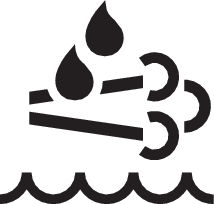 ), the urea solution tank needs to be refilled. If not refilled for a considerable mileage, visual warning system will escalate
the intensity by displaying the message "Refill urea" with SCR warning lamp (
), the urea solution tank needs to be refilled. If not refilled for a considerable mileage, visual warning system will escalate
the intensity by displaying the message "Refill urea" with SCR warning lamp ( ).
).
In this case, the urea solution tank soon needs to be refilled. The remaining urea solution in the urea solution tank approaches
to too low level the warning message "Refill urea in 000km or vehicle will not start" with SCR warning lamp ( ). "xxx km(mile)" represents the remaining travel distance allowed, so do not continue driving to the limit of the remaining
travel distance without refilling.
). "xxx km(mile)" represents the remaining travel distance allowed, so do not continue driving to the limit of the remaining
travel distance without refilling.
Otherwise, the vehicle can't be restarted once the engine is turned off by the ENGINE START/STOP button. Based on the driving pattern, environmental condition and road profile, the deducted remaining mileage may differ from the actual travel distance. When "Low urea" or "Refill urea" message is displayed, a sufficient amount of urea solution must be added. When "Refill urea in 000km or vehicle will not start" message is displayed, refill a sufficient amount of urea solution.
When "Refill urea tank or vehicle will not start" message is displayed with SCR warning lamp ( ), the vehicle can't be restarted once the engine is turned off by the ENGINE START/STOP button. For the above cases, full
replenishment is always recommended.
), the vehicle can't be restarted once the engine is turned off by the ENGINE START/STOP button. For the above cases, full
replenishment is always recommended.
Refer to More Details.
Malfunction with the SCR system (if equipped)
|
Upon detecting a malfunction |
Driving 50 km after detecting a malfunction |
|
|---|---|---|
|
Urea solution system failure (= no urea solution injection) |
 |
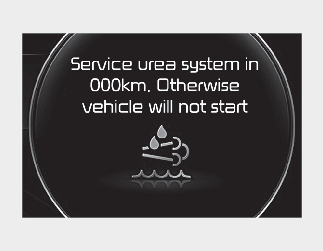 |
|
Incorrect urea solution detected (= abnormal urea solution) |
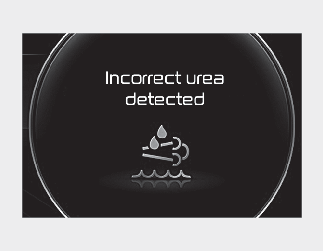 |
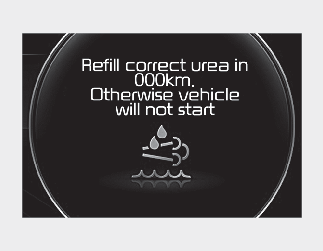 |
|
Abnormal urea-solution consumption (= post treatment failure) |
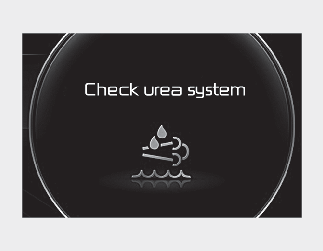 |
 |
SCR system has malfunction due to disconnected electrical components, incorrect urea solution and so on.
"xxx km (mile)" represents the remaining travel distance allowed, so do not continue driving to the limit of the remaining travel distance without fixing the source of the malfunction. Otherwise, the vehicle can't be restarted once the engine is turned off by the ENGINE START/STOP button. In this case, have your vehicle inspected by a professional workshop. Kia recommends to contact an authorised Kia dealer/service partner.
Clearing the vehicle-restarting restriction (if equipped)
|
No restart |
|
|---|---|
|
Low urea solution level |
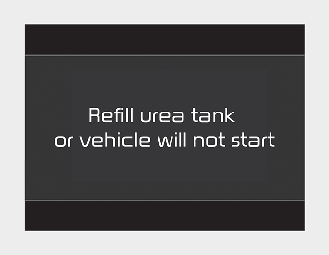 |
|
Urea solution system failure (= no urea solution injection) |
 |
|
Incorrect urea solution detected (= abnormal urea solution) |
 |
|
Abnormal urea-solution consumption (= post treatment failure) |
 |
Once the inducement system reached to final status and disabled the vehicle restart, it will only be deactivated in case the urea solution tank is replenished or the malfunctions have been rectified. If the vehicle can't be restarted with "Refill urea tank or vehicle will not start" message, refill a sufficient amount of urea solution, wait for minutes and try vehicle starting again. If vehicle starting is not possible regardless of urea solution level, have your vehicle inspected by a professional workshop. Kia recommends to contact an authorised Kia dealer/service partner.
Adding urea solution
To refill urea solution with a refill hose
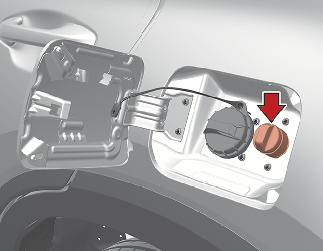
* Pay great caution not to add the urea solution into the fuel tank. If not, it surely applies adverse impact on the vehicle performance, causing various malfunctions.
* Never use urea solution mixture with additives or water. It may allow foreign substances to enter the urea solution tank. If so, it surely applies adverse impact on the vehicle performance, causing various malfunctions.
* Use only the ISO 22241-specified urea solution. Any unauthorised urea solution surely applies adverse impacts on the vehicle performance, causing various malfunctions.
Refer to More Details.
To refill urea solution with a refill bottle
* Pay great caution not to add the urea solution into the fuel tank. If not, it surely applies adverse impact on the vehicle performance, causing various malfunctions.
* Pay great caution not to overfill the (completely) filled urea solution tank by force whilst refilling urea solution from a refill bottle. An over-filled urea solution tank will be expanded when it becomes frozen and this can cause a serious malfunction of the urea solution tank or urea solution system.
* Never use urea solution mixture with additives or water. It may allow foreign substances to enter the urea solution tank. If so, it surely applies adverse impact on the vehicle performance, causing various malfunctions.
* Use only the ISO 22241-specified urea solution. Any unauthorised urea solution surely applies adverse impacts on the vehicle performance, causing various malfunctions.
Adding urea solution: Every approximately 5,600 km (The urea solution consumption is dependent on the road profile, driving pattern and environmental condition)
* It takes some time to update the cluster gauges after the urea solution injection.

-
Do not apply any external impact on the DPF system. It may damage the catalyst, which is equipped inside the DPF system.
-
Do not arbitrarily modify or manipulate the DPF system by redirecting or lengthen the exhaust pipe. It may adversely impact the DPF system.
-
Avoid contact with drained water from the exhaust pipe. The water is slightly acid and harmful to skin. If contacted, thoroughly wash it.
-
Any arbitrary manipulation or modification of the DPF system may cause a system malfunction. The DPF system is controlled by a complex electronic control unit.
-
Wait for the DPF system to cool down before the maintenance service, as it is hot due to heat generation. Otherwise, it may cause a skin burn.
-
Add only the specified urea solution, when your vehicle is equipped with the urea solution system.
-
The urea solution system (i.e. urea solution nozzle, urea solution pump, and DCU) operates for approximately 2 minutes more to eliminate the remaining urea solution inside, even after the ENGINE START/STOP button is pressed to the OFF position. Before the maintenance service, make sure that the urea solution system is completely turned OFF.
-
A urea solution of poor quality or any unauthorised liquids may damage the vehicle components, including the DPF system. Any unverified additives in the urea solution may clog the SCR catalyst and cause other malfunctions, which require the expensive DPF system to be replaced.
-
When urea solution comes in contact with the eyes or the skin, you should thoroughly wash the contaminated skin area.
-
When you swallow urea solution, thoroughly rinse your mouth and drink a lot of fresh water. Then, immediately consult a doctor.
-
When your cloth is contaminated with urea solution, immediately change your cloth.
-
When you have an allergic reaction to urea solution, immediately consult a doctor.
-
Make sure that urea solution is kept out of reach from children.
-
Wipe off any urea solution spillage with water or cloth. When urea solution is crystalised, wipe it off with a sponge or a cloth, which was dampened in cold water.
When urea solution spillage is exposed in air for an extended period of time, it is crystalised in white, damaging the vehicle surface.
-
Urea solution is not a fuel additive. Thus, it should not be injected to the fuel tank. Otherwise, it may damage the engine.
-
Urea solution is an aqueous solution, which is inflammable, non-toxic, colourless and odourless.
-
Store the urea solution tank only in well-ventilated locations. When urea solution is exposed to the hot temperature at approximately 50°C for an extended period of time (i.e. under direct sunlight), the chemical decomposition may occur, emitting ammonia vapour.
Storing urea solution (if equipped)
-
It is improper to store urea solution in containers made of unsuitable materials like aluminium, copper alloy, non-alloyed still and galvanised steel.
The urea solution dissolves metal materials, severely damaging the exhaust purification system to be non-repairable.
-
Store urea solution only in containers made of the following materials.
-
DIN EN 10 088-1-/-2-/-3-specified CR-Ni steel, Mo-Cr-Ni steel, Polypropylene and Polyethylene
-
Urea solution purity
-
The following situations may damage the DPF system.
-
Fuels or any unauthorised liquids are added into the urea solution tank.
-
Additives are mixed with urea solution.
-
Water is added to dilute the urea solution.
-
-
Use only the ISO 22241- or DIN70070-specified urea solution. When any unauthorised urea solution is added to the urea solution tank, have your vehicle inspected by a professional workshop. Kia recommends to contact an authorised Kia dealer/service partner.
-
When any unauthorised impurities enter the urea solution tank, it may lead to the following problems.
-
Increased emission
-
Malfunction with the DPF system
-
Engine failure
-
Never add any used urea solution, which is drained from the urea solution tank (i.e. whilst maintaining the vehicle). Its purity cannot be guaranteed. Always add new urea solution.
|
Specification of the standard urea solution |
Liquid such as diesel, petrol and alcohol shall never be used for SCR system. Any fluid other than recommended urea solution (conform to ISO22241 or DIN70070) can damage SCR system hardware and deteriorate vehicle emission. |

-
When opening the urea solution tank cap at high outside temperatures, ammonia vapours may escape. Ammonia vapours have a pungent smell and primarily cause irritation of the:
-
Skin
-
Mucous membranes
-
Eyes
You may experience a burning sensation in your eyes, nose and throat, as well as coughing and watering of the eyes. Do not inhale ammonia vapours. Do not allow urea solution to come in direct contact with your skin. It is hazardous to your health. Wash any affected areas off with plenty of clean water. If necessary, consult a doctor.
-
-
When handling with urea solution in closed space, ensure good ventilation. When the bottle of urea solution container is opened, pungent smelling fumes may escape.
-
Keep urea solution out of reach of children.
-
When urea solution overflows the vehicle surface, wash out the surface with clean water to prevent any corrosion.
-
When replenishing, be careful lest the urea solution should overflow.
-
In case the vehicle was parked at very low ambient temperature (below -11 degree Celsius) for a long time, the urea solution will be frozen in the urea solution tank. With frozen urea solution, the urea solution tank level may not be detected correctly until the urea solution will be defrosted by activated heater. Incorrect urea solution or diluted urea solution can increase the freezing point, and thus defrosting may not be properly done by the heater which is activated below certain temperatures. This phenomenon may cause malfunction of the SCR system which can lead to the prohibition of engine restarting.
-
The time to defrost the urea solution varies in accordance with driving conditions and outside temperatures.

-
If defective urea solution or unrecommended liquid is supplied, damage on car parts such as emission reduction devices can be caused. If defective fuel is added, foreign objects will be accumulated to SCR catalyst and cause it to get clogged and break.
After adding incorrect urea solution, please visit the nearby authorised Kia dealer/service partner as early as possible.
-
Liquid that are not recommended such as diesel, petrol, and alcohol shall never be used other than the recommended urea solution that satisfy ISO22241 or DIN70070.
-
If defective urea solution or liquid that is not recommended is supplied, there may be damage on the parts of the vehicle such as processing device. If defective fuel is used, foreign objects will be accumulated to SCR catalyst and cause catalyst pushed away or breaking.